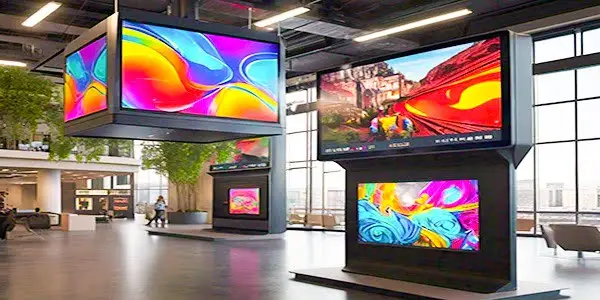Creative Ways of Capturing Audiences with Digital Display
Introduction
Today’s world is fast-paced, making it difficult to capture and retain audience attention. Digital displays are powerful ways to attract and engage people in a variety of settings. Digital displays can be used in retail and public places. What makes a digital screen truly effective? This article offers creative ideas to engage and capture your audience through digital displays.
Understanding Digital Displays
Types and Definitions of Digital Displays
The term digital displays refers to a variety of screens that are used for presenting multimedia content. You can find them in many different forms, such as LCD panels, LED screens, and projection displays. The different types serve different purposes, such as high-definition video walls or interactive touchscreens.
The Evolution of Digital Displays Through the Years
Digital displays have had a fascinating journey. The evolution of technology from the old CRT monitors to the sleek, high-resolution displays we have today has been fascinating.
Digital displays: The power of visuals
Visuals and Audience Engagement
Visuals have a powerful ability to capture attention. Visuals are processed faster by people than text, and they’re more likely to retain visual information. Digital displays are, therefore, an excellent medium to deliver impactful messages.
The Psychological Aspects Of Visual Appeal
It’s not only about aesthetics but also about psychology. Colors, shapes, and movements can influence emotions and perceptions. These psychological factors can be used to create digital displays that are more persuasive and engaging.
Principles of Design for Effective Digital Displays
Clarity and Simplicity
Keep designs clear and simple to ensure that your message can be easily understood. A display that is overloaded with information will overwhelm the viewer and decrease its effectiveness.
The Color Theory of Light and its Application
Colours play a crucial role in design. Designers can use colour theory to create visually pleasing displays and communicate the correct message. Warm colours such as red and orange can create excitement, while cool colours like blue or green can calm.
Readability and Typography
It is important to choose the correct fonts and ensure that they are readable. The font should match the identity of the brand and should make the text legible at a distance. The key is to avoid overly decorative fonts and ensure that the text contrasts with the background.
Creative Content Ideas for Digital Displays
Static vs. Dynamic content
Videos and animations can engage viewers more than still images. This catches attention and holds viewers’ interest longer. Static content has a place, too, particularly for simple messages.
Use Videos and Animations
Videos and animations can make a digital display come to life. You can use them to create an immersive environment, tell a tale, show a product, or demonstrate it. It is important to make sure that the elements do not distract but rather enhance your message.
Data Visualization and Infographics
Data visualization and infographics can be a great way to present complex information. These stories combine text and visuals to convey information effectively.
Innovations in Digital Displays
Interactive Touchscreens
The interactive touchscreens encourage audience interaction, increasing engagement. These touchscreens are used extensively in museums and exhibits, as well as retail stores, to display interactive information about products or provide educational content.
Virtual Reality (VR), Augmented Reality, and
AR and VR technology can offer immersive digital experiences. AR is the overlaying of digital data onto real-world objects, whereas VR creates an entirely virtual world. These technologies are increasingly being used for marketing and entertainment.
Holography and 3D Displays
Holography and 3D displays add depth to the visuals. Although these technologies are new, they have great potential to create memorable and captivating experiences.
Successful Case Studies for Digital Displays
Retail
Digital displays are used in retail to create interactive displays of products, dynamic window displays, and a personalized shopping experience. Nike flagship stores, for example, use interactive screens and large video walls to improve the customer experience.
Exhibits and Events
Digital displays are a great asset for events and exhibitions. Digital displays can be used to provide live information, direct attendees, and make engaging presentations. One notable example of this is using massive LED screens to show live presentations and feeds at technology conferences.
Example from Public Spaces
Digital displays are used in public spaces such as airports, city centers, and shopping malls to help with wayfinding and advertising. They can also be used for information distribution. Times Square is New York City’s prime example of how digital displays create an exciting and dynamic atmosphere.
Measure the effectiveness of digital displays.
Key Performance Indicators (KPIs).
To measure the effectiveness of digital display, it is important to track various KPIs such as dwell time and viewer engagement. These metrics can help you determine if the display achieves its goals.
Methods and Tools for Tracking Engagement
There are many tools for tracking engagement, such as sensors, software analytics, and cameras. The tools can provide useful data about how the audience interacts with displays. This allows for continuous improvements.
Digital Display Implementation: Challenges and Solutions
Common Challenges Faced
Digital displays come with challenges, such as initial costs, content management issues, and technical problems. Common challenges include ensuring that displays integrate well with existing systems and that content is relevant and fresh.
Best Practices and Practical Solutions
For these issues to be overcome, you need a clearly defined strategy, reliable technology, and regular content updates. Working with experienced providers can ensure a smoother implementation.
Digital Display Trends for the Future
The Next Decade: Predictions
Digital displays are set to have a bright future, as advances in technology will lead to innovative and immersive digital experiences. AI-driven personalization of content and new display materials will revolutionize this industry.
Emerging Technologies To Watch
New technologies, such as OLEDs, quantum dots, micro-LEDs, and other emerging displays, offer improved colour accuracy and brightness. They also use less energy. These developments will help companies stay on top of their game.
How to Create a Digital Display Strategy
How to develop a strategy
The process of developing a digital strategy includes several steps, including defining your goals, identifying the target audience, choosing the best technology, and creating compelling content. Plan for maintenance and updating.
Aligning displays with business goals
By aligning digital displays to business objectives, they can contribute to the strategy. Displays should be used to support the objectives of increasing brand recognition, driving sales, or improving customer experience.
Maintenance of Digital Displays: Best Practices
Tips for Regular Maintenance
To ensure the effectiveness and longevity of digital displays, regular maintenance is essential. Cleaning screens, checking technical problems, and updating the software are all part of this maintenance.
Ensuring Content Freshness
It is important to keep content relevant and fresh. Content that is regularly updated to reflect the latest promotions, events, trends, and other factors keeps audiences engaged.
Considerations for Ethical Use of Digital Displays
Privacy Issues
Privacy concerns are becoming more important with the advent of personalized and interactive displays. Data handling should be done responsibly to protect audience privacy.
Avoiding Information overload
It’s vital not to leave the audience with enough information. Keep your messages focused and concise to maintain audience engagement.
Budgeting Digital Display Projects
Factors of Cost to Be Considered
When budgeting for digital displays, it is important to consider a variety of factors. These include hardware, software, and content creation. To allocate your resources efficiently, it’s crucial to understand these costs.
How to Maximize ROI
Focus on the creation of high-quality content and the use of reliable technology to maximize your ROI. Regularly measure performance. Long-term gains can be achieved by investing in scalable solutions.
Digital display art is an amalgamation of strategy, creativity, and technology. Businesses can use best practices to create digital displays that are captivating and capture the attention of their audience by understanding visuals and embracing technology innovations. Digital displays will continue to grow in possibilities as technology advances, providing even more engaging and exciting experiences for the future.
FAQs
What is a digital display?
Digital displays, also known as electronic screens, are used to display multimedia content such as images, videos, and interactive elements. These displays are used widely in retail settings, public places, and events.
What are the benefits of digital display?
Content that is dynamic and appealing to the eye can enhance engagement with digital displays. Interactive features such as AR and touchscreens encourage participation.
Which digital display technologies are innovative?
Digital displays incorporate innovative technologies such as interactive touchscreens (AR), Virtual Reality (VR), 3-D displays (holography), and 3D displays. The technologies provide immersive, interactive experiences.
What is the best way to measure my digital display’s success?
Key performance indicators, such as dwell time and conversion rate, can help measure success. These metrics can be tracked using tools like cameras, sensors, and analytics software.
Which future trends in digital display should I be on the lookout for?
The future trends will include the use of display technologies such as OLEDs and micro-LEDs, AI-driven content personalization, and more immersive technology like AR and VR.







